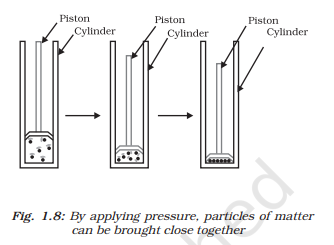Matter in Our Surroundings Class 9 Notes | Science Chapter 1 Class 9 Notes
In this chapter, we shall learn about matter based on its physical properties. Chemical aspects of matter will be taken up in subsequent chapters.
Matter
Anything in the universe occupying some space and having mass is called matter. The matter is made up of extremely small particles.
Physical Nature of Matter
- The matter is made up of particles.
- Particles are very very small in size.
- Particles of matter are continuously moving.
Characteristics of particles
- Particles of matter have space between them.
- Particles of matter are continuously moving.
- Particles of matter attract each other.
- Particles of matter are very small in size
Kinetic Energy
Particles of matter are continuously moving, so they possess a kind of energy known as kinetic energy. As the temperature rises, particles of matter move faster. So, we can say that as the temperature increases the kinetic energy of the particles also increases.
The energy possessed by an object due to its motion is called kinetic energy.
Diffusion
The intermixing of particles of different types of matter of their own is called diffusion. We also observe that on heating diffusion becomes faster.
States of Matter
There are three states of matter:
- Solid
- Liquid
- Gas
These states of matter arise due to the variation in the characteristics of the particles of matter.
Why does gas exert pressure on the walls of the container?
In a gaseous state, particles move about randomly at high speed. Due to this random movement, the particles of the matter hit each other ad also the walls of the container.
Can matter change its state?
On increasing the temperature of solids, the kinetic energy of the particles increases. Due to an increase in kinetic energy, the particles start vibrating at a greater speed. The energy supplied by heat overcomes the forces of attraction between the particles. The particles leave their fixed positions and start moving more freely. A stage is reached when the solid melts and is converted into liquid.
Melting Point
The minimum temperature at which a solid melts to become a liquid at the atmospheric pressure is called its melting point.
The melting point of ice is 273K.
Latent heat of fusion
The amount of heat energy that is required to change 1kg of a solid into liquid at atmospheric pressure at its melting point is known as the latent heat of fusion.
Latent heat of vapourization
The amount of heat energy required to change 1kg of liquid into vapors at its boiling point is called the latent heat of vapourization.
Ways by which matter can its state
Change of temperature
Chang of pressure
Sublimation
A change of state directly from solid to gas without changing into a liquid state is called sublimation.
Examples - Camphor, ammonium chloride.
Deposition
The direct change of gas to solid without changing into liquid is called deposition.
Dry ice
Carbon dioxide is stored under high pressure. Solid CO2 gets converted into the gaseous state on the decrease of pressure to 1 atmosphere without coming into a liquid state. This is the reason why carbon dioxide is known as dry ice.
Effects of pressure on matter
When we increase pressure and decrease temperature then in some cases gases directly change into solids. Example - Dry ice.
Interconversion of states of matter
Evaporation
The phenomenon of change of a liquid into vapors at ant temperature below its boiling point is called evaporation.
Humidity
The amount of water vapor present in the air is called Humidity.
Factors on which the rate of evaporation depends
An increase in the surface area:
We know that evaporation is a surface phenomenon. If the surface area is increased, the rate of evaporation increases. For example, while putting clothes to drying up we spread them out.
An increase in temperature:
With the increase in temperature, more particles get enough kinetic energy to go into the vapor state.
A decrease in humidity:
Humidity is the amount of water vapor present in the air. The air around us cannot hold more than a definite amount of water vapor at a given temperature. If the amount of water in the air is already high, the rate of evaporation decreases.
An increase in wind speed:
It is a common observation that clothes dry faster on a windy day. With the increase in wind speed, the particles of water vapor move away with the wind, decreasing the amount of water vapor in the surrounding.
NCERT Class 9 Science Notes
- Chapter 1 Matter in Our Surroundings Class 9 Notes
- Chapter 2 Is Matter Around Us Pure Class 9 Notes
- Chapter 3 Atoms and Molecules Class 9 Notes
- Chapter 4 Structure of the Atom Class 9 Notes
- Chapter 5 The Fundamental Unit of Life Class 9 Notes
- Chapter 6 Tissues Class 9 Notes
- Chapter 7 Motion Class 9 Notes
- Chapter 8 Force and Laws of Motion Class 9 Notes
- Chapter 9 Gravitation Class 9 Notes
- Chapter 10 Work and Energy Class 9 Notes
- Chapter 11 Sound Class 9 Notes
- Chapter 12 Improvement of Food Resources Class 9 Notes






